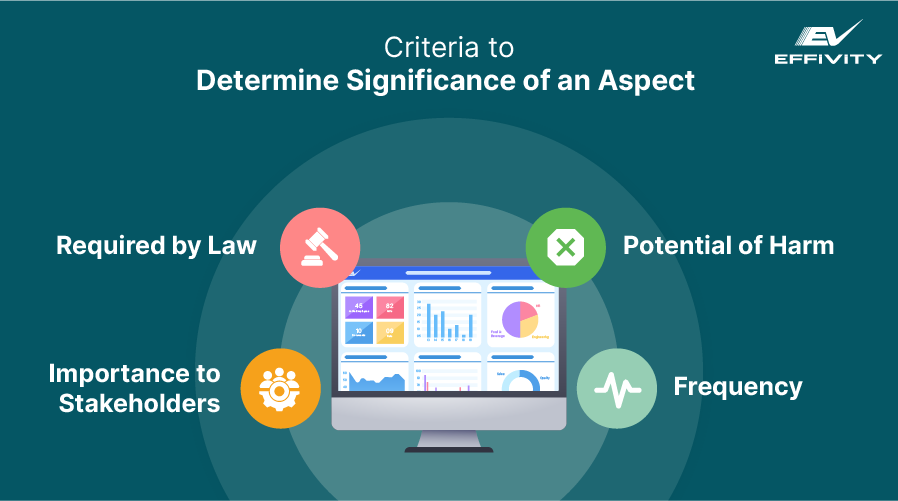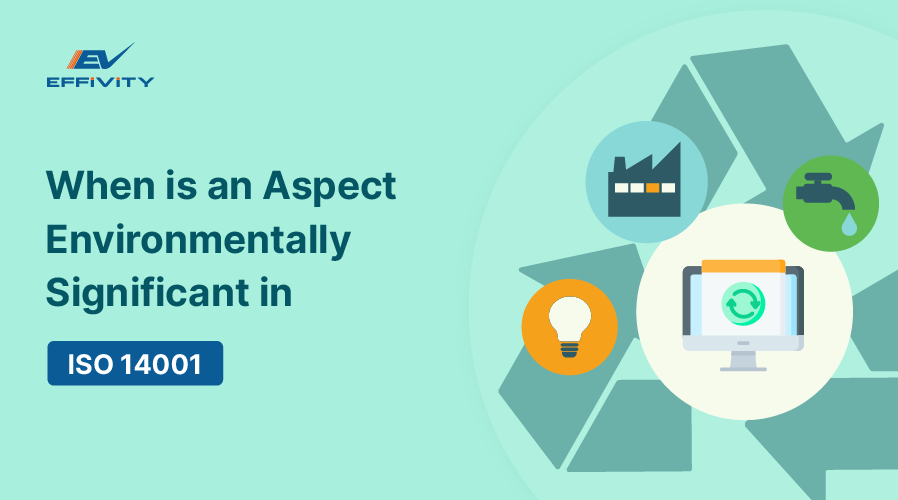The ISO 14001 standard sets the requirements for implementing and managing an Environmental Management System. A fundamental part of implementing ISO 14001 is identifying and evaluating the significance of various environmental aspects during the planning phase.
According to ISO 14001:2015, an environmental aspect is defined as an element of the organization’s activities, products, or services that can impact the environment.
Simply put, environmental aspects are how your business processes interrelate with the environment. Since ISO 14001 does not provide any criteria to determine the significance of an aspect, how do you decide which interaction is more important?
Let’s explore the need to determine significant aspects and the factors to consider in deciding which aspects are significant in environmental management.
What is an Environmental Aspect?
An environmental aspect is how a business activity, product, or service impacts the environment. For instance, the wastewater produced during manufacturing and dumped untreated can lead to water pollution and requires proactive waste management of the aspect.
Some other examples of environmental aspects include-
- Contamination of soil
- Harmful emissions into the atmosphere
- Consumption and release of energy
- Use of natural resources
- Waste generation
All such aspects can lead to environmental impact – positive or negative.
What are the ISO 14001 Requirements for Environmental Aspects?
The ISO 14001 standard requires organizations to establish a procedure for identifying environmental aspects and the activities associated with them that are under control. After identification, you must determine their significance to prioritize them accordingly.
In addition, you must also define the lifecycle stage of a particular environmental aspect. The ISO 14001 Annex A also lists the categories to divide environmental aspects and make management easier.
Why Determine ISO 14001 Significant Aspects?
Every business activity or the products or services they offer impacts the environment in some way, which can be local, regional, global and can vary in significance. Besides, these impacts can occur at any time during the lifecycle of the product , service, or activity.
As a result, it can lead to a situation where everything can seem critical and nothing gets the first priority. However, by assigning significance to various environmental aspects, you can highlight the areas where controls and improvements are required. When you recognize the environmental interactions that are most important and should be monitored, it becomes easy to set priorities and ensure compliance with ISO 14001.
This also makes it easy to allocate resources to the relevant areas and get a high return on investment in your EMS. If you think about it, when only a few aspects are critical to environmental management, spending resources on all interactions is only wasteful.
Therefore, all the critical environmental aspects should be tracked on a spreadsheet or automated environmental management software to identify the significant ones. Here’s a simple way to classify various environmental aspects within your organization to better prioritize them-
- Controlled
- Significant
- Influenced
- Non-significant
- Positive
Criteria to Determine the Significance of an Aspect
Before establishing criteria to determine the significance of an environmental aspect, the organization must determine its context. In essence, this means considering several environmental aspects, such as the condition of the environment, expectations of the relevant stakeholders and legal and regulatory requirements .
Here are some general criteria that you can consider to determine which of your environmental aspects are significant-

1. Required by Law
If a law requires you to establish, control and manage a certain environmental aspect, then that aspect must be classified as significant. For instance, if your wastewater treatment plant is required to use certain chemical levels before discharging it to the effluent system, the measurement and management of these chemical levels will be regulated by law.
As a result, such aspects should be considered significant. If the management and control of such aspect fails, or the measurement is not done accurately, the organization will be legally non-compliant.
2. Potential of Harm
Another criterion to consider in determining the significance of an aspect is to know the harm potential of that aspect. An environmental aspect with a higher potential to affect the environment should be managed and controlled on priority.
If your chemical process uses a highly poisonous chemical, it has a bigger possibility of damaging the environment when disposed of than a relatively harmless chemical. Similarly, if there is high printing waste in an office, reducing this waste to decrease the use of paper, printing chemicals and electricity may be a significant environmental aspect within the environment management system.
3. Frequency
The frequency of a certain activity can also determine which aspect is environmentally significant within an organization. For instance, if you use harmful chemicals for cleaning and maintaining machinery but only once a year, it may not seriously impact the environment if any potential spill is contained.
On the other hand, processes that use less harmful chemicals but regularly are likely to have a greater environmental impact. As a result, it becomes more important to monitor and control such aspects.
4. Importance to Stakeholders
For any business, their stakeholders aren’t just the employees, customers and shareholders. Any individual living in the society or within the vicinity of the business premises is also a stakeholder for the business and their needs must be considered when implementing an EMS.
For instance, if your manufacturing process produces loud noise or a horrible smell that affects those living nearby, you must consider it an environmentally significant aspect and take steps to prioritize it.
Prioritize Your Environmental Aspects
Determining which environmental aspects are significant for your business makes it easier to prioritize actions and show your employees what is more important to the business. By focusing on the most relevant aspects, you can easily control and even potentially eliminate those aspects from your business by changing the processes involved and reduce impact on the environment.
This is not only beneficial for the business but also ensures the protection of the environment.






























